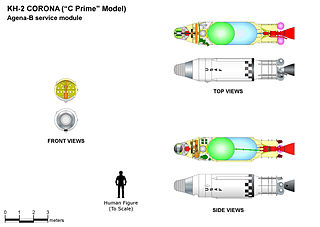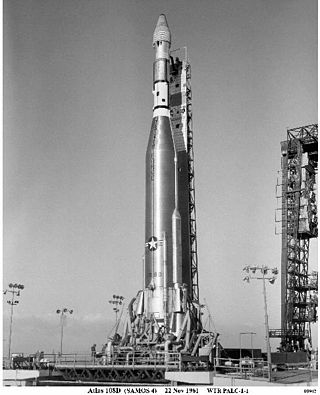Discoverer 30, also known as Corona 9022, was an American optical reconnaissance satellite which was launched in 1961. It was a KH-3 Corona''' satellite, based on an Agena-B rocket.

Discoverer 25, also known as Corona 9017, was an American optical reconnaissance satellite which was launched in 1961. It was the fifth of ten Corona KH-2 satellites, based on the Agena-B.
Kosmos 36, also known as DS-P1-Yu #1 was a satellite which was used for use in calibrating the Dnestr space surveillance and as a radar calibration target, for tests of anti-ballistic missiles. It was launched by the Soviet Union in 1964 as part of the Dnepropetrovsk Sputnik programme. It was built by the Yuzhnoye Design Bureau.

Samos 4 was an American reconnaissance satellite which was lost in a launch failure in 1961. It was a film-return reconnaissance spacecraft, meaning that it returned images in a film capsule at the end of its mission. It was operated as part of the Samos programme. Samos 4 was the first of three Samos-E5 spacecraft to be launched; Samos-E5 satellites were based on an Agena-B, and carried a camera with a focal length of 1.67 metres, and a resolution of 1.5 metres.
FTV-2203, also known as Samos 5, was an American reconnaissance satellite launched in 1961 as part of the Samos programme. It was a film return reconnaissance spacecraft, meaning that it returned images in a film capsule at the end of its mission. FTV-2203 was a Samos-E5 spacecraft, based on the Agena-B. It carried a camera with a focal length of 1.67 metres and a resolution of 1.5 metres.
Discoverer 24, also known as Corona 9018A, was an American area survey optical reconnaissance satellite which was launched in 1961 but failed to achieve orbit. It was a KH-5 Argon satellite, based on an Agena-B. It was the third KH-5 to be launched.
FTV-1126, also known as Corona 9034A, was an American area survey optical reconnaissance satellite launched in 1962. It was a KH-5 Argon satellite, based on an Agena-B. It was also unofficially known as Discoverer 41, a continuation of the designation sequence used for previous US reconnaissance satellites, which had officially been discontinued after Discoverer 38. It was the first KH-5 satellite to complete its mission successfully.
FTV-1132, also known as the Corona 9042A, was an American area survey optical reconnaissance satellite which was launched in 1962. It was a KH-5 Argon satellite, based on an Agena-B. The satellite operated successfully, but its film capsule was lost during recovery due to a parachute failure.

Discoverer 22, also known as Corona 9015, was an American optical reconnaissance satellite which was lost in a launch failure in 1961. It was the fourth of ten Corona KH-2 satellites, based on the Agena-B.

Discoverer 26, also known as Corona 9019, was an American optical reconnaissance satellite which was launched in 1961. It was the sixth of ten Corona KH-2 satellites, based on the Agena-B.

Discoverer 28, also known as Corona 9021, was an American optical reconnaissance satellite which was lost in a launch failure in 1961. It was the seventh of ten Corona KH-2 satellites, based on the Agena-B.

Discoverer 16, also known as Corona 9011, was an American optical reconnaissance satellite which was lost in a launch failure on 26 October 1960. It was the first of ten Corona KH-2 satellites, based on the Agena-B.

Discoverer 17, also known as Corona 9012, was an American optical reconnaissance satellite launched on 12 November 1960 at 20:38:00 GMT. It was the second of ten Corona KH-2 satellites, based on the Agena-B.
Discoverer 29, also known as Corona 9023, was an American optical reconnaissance satellite which was launched in 1961. It was the first KH-3 Corona''' satellite, which was based on an Agena-B rocket.
Discoverer 31, also known as Corona 9024, was an American optical reconnaissance satellite which was launched in 1961. It was a KH-3 Corona''' satellite, based on an Agena-B.
Discoverer 32, also known as Corona 9025, was an American optical reconnaissance satellite which was launched in 1961. It was a KH-3 Corona''' satellite, based on an Agena-B.

Discoverer 33, also known as Corona 9026, was an American optical reconnaissance satellite which was lost in a launch failure in 1961. It was the eighth of ten Corona KH-2 satellites, based on the Agena-B.

Discoverer 35, also known as Corona 9028, was an American optical reconnaissance satellite which was launched in 1961. It was the last of ten Corona KH-2 satellites, based on the Agena-B.
Discoverer 36, also known as Corona 9029, was an American optical reconnaissance satellite which was launched in 1961. It was a KH-3 Corona satellite, based on an Agena-B rocket. It was the penultimate KH-3 satellite to be launched, the last successful mission, and the most successful of the program.
Discoverer 37, also known as Corona 9030, was an American optical reconnaissance satellite which was lost in a launch failure in 1962. It was the last KH-3 Corona‴ satellite, which was based on an Agena-B rocket.

